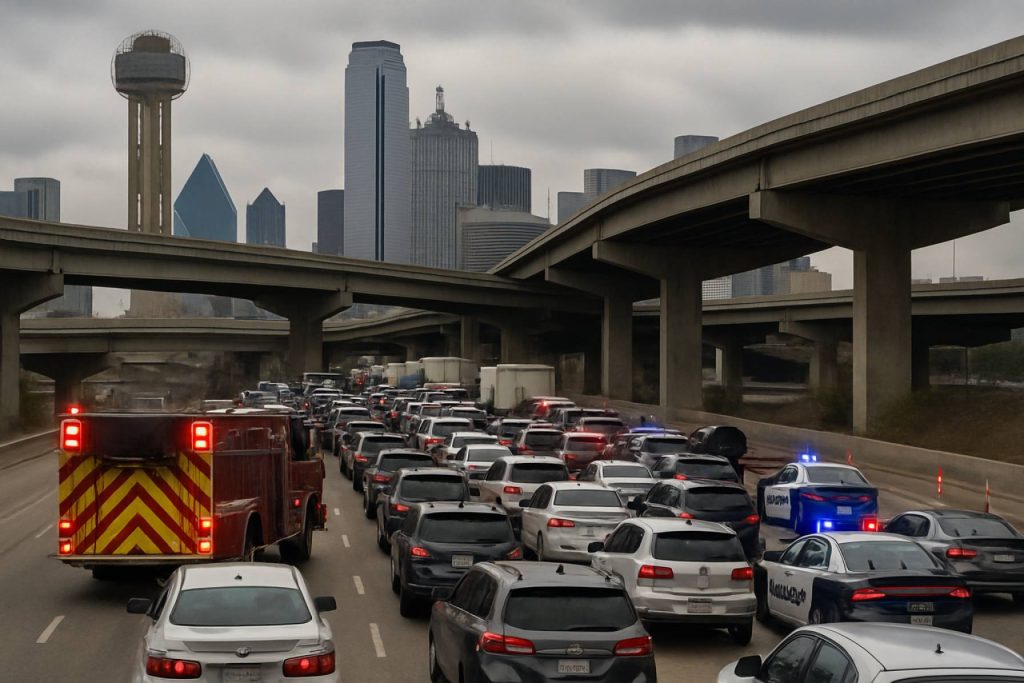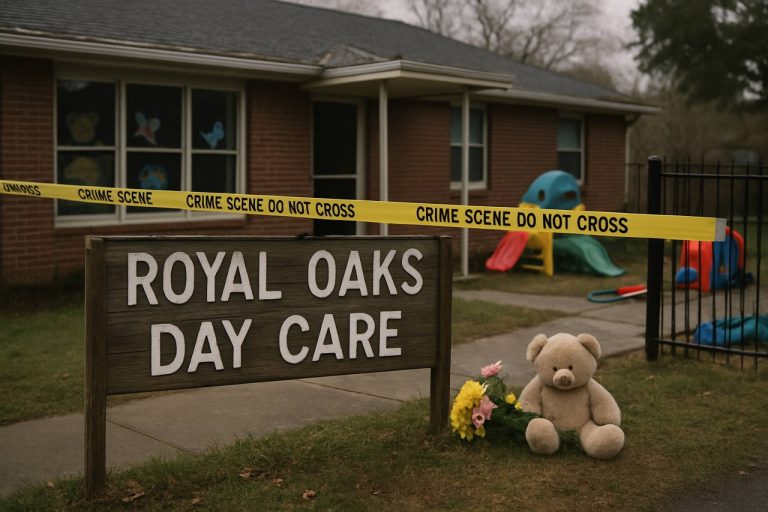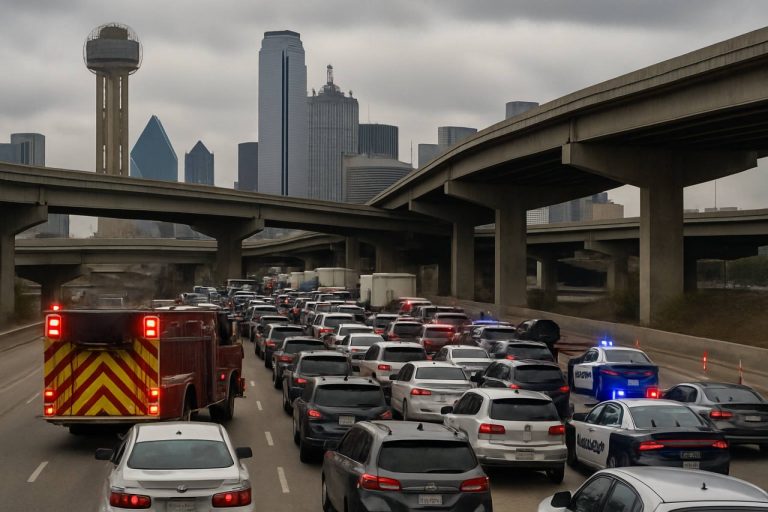
- A pedestrian was fatally struck while crossing U.S. 75 near the busy I-635 interchange, causing significant Dallas traffic disruptions and highlighting pedestrian safety concerns.
- Emergency responders promptly arrived, but the victim did not survive; lanes were closed and traffic rerouted, impacting commuters and city commerce.
- The incident has renewed discussions about the dangers pedestrians face around high-speed Dallas highways and the importance of infrastructure improvements.
- Authorities urge drivers and pedestrians alike to exercise caution and patience, as investigations continue and debates about safety and urban development intensify.
- This event underscores the ongoing need for vigilance, public safety initiatives, and community empathy on Dallas roads.
The relentless pulse of Dallas traffic shuddered to a stop late Tuesday morning as sirens wailed along the sprawling web of highways near the I-635 and U.S. 75 interchange. Under the unyielding Texan sun, uniformed officers cordoned off southbound lanes, their presence a stark reminder of how swiftly routine can turn to crisis.
Shortly before noon, responders arrived at the chaotic scene where a pedestrian—yet to be identified—had been struck while attempting to cross the fast-moving expanse of U.S. 75. Emergency crews from Dallas Fire-Rescue and police converged, their coordinated efforts underscoring the gravity of the moment. Attempts to save the victim proved futile; the pedestrian succumbed to injuries, and an ordinary drive transformed into a moment of collective pause.
As flashing lights painted streaks across city streets, Dallas authorities rerouted traffic to east and westbound I-635. The interchange, a vital artery for the city’s commerce and commuters, quickly snarled with redirected vehicles and frustrated drivers scanning for alternate escape routes. For those accustomed to the familiar rhythm of highway travel, today’s interruption was a harsh blow—a reminder that safety is fragile on these ribbons of concrete.
Officials issued a call for patience, urging motorists to avoid the area as the investigation unfolded. Details on the cause of the accident remain scarce, but the incident has reignited discussions among local safety advocates about the vulnerability of pedestrians near high-speed thoroughfares. Major metropolitan areas like Dallas wrestle daily with the challenges of merging pedestrian needs and vehicle flow, a flashpoint as urban development densifies and the stakes heighten.
Roadways such as U.S. 75 and I-635 serve as lifelines for millions in the Dallas-Fort Worth region. Events like these throw a spotlight on the necessity for ongoing public safety initiatives and infrastructure improvements. National organizations, including those featured on NHTSA, consistently stress vigilance from both drivers and walkers alike, aware that every crossing and merge holds potential risks.
This day’s tragedy, marked by the solemn procession of emergency vehicles and the echo of unanswered questions, asks all who travel these highways to recommit to safety and attentiveness. The sudden absence of one life reminds us: in an instant, the pace of the city can change, and routine can become remembrance.
Key Takeaway: As traffic surges resume in the coming hours, Dallas carries a sobering lesson forward—caution, awareness, and empathy are not merely virtues, but necessities when lives are at stake on the open road.
Dallas Interchange Tragedy: What You Need to Know, Why It Happens, and Steps to Stay Safe on the Roads
The Dallas Pedestrian Accident: Facts, Figures, and Practical Insights
A fatal incident near the busy I-635 and U.S. 75 interchange rocked Dallas this week, highlighting the ever-present dangers for pedestrians in high-traffic metros. While the source article captured the immediate aftermath, several vital aspects deserve further exploration—especially for those living, commuting, or working near urban highways.
—
Additional Key Facts and In-Depth Insights
1. Pedestrian Fatalities Are Rising – Both Nationally and in Texas
– According to the Governors Highway Safety Association, U.S. pedestrian deaths reached a 40-year high in 2022, with more than 7,500 fatalities ([source](https://www.nhtsa.gov)).
– Texas regularly ranks among the top five states for pedestrian fatalities, with over 800 deaths annually, driven by rapid population growth and urban sprawl.
2. Why Are Interchanges Like I-635 & U.S. 75 So Dangerous?
– Design Limitations: Highways and interchanges feature wide lanes, high speeds, and limited pedestrian infrastructure.
– Poor Visibility: Multiple on-ramps, variable lighting, and signage can make it hard for drivers to spot pedestrians.
– Crossing Temptations: Areas near interchanges sometimes attract pedestrians due to bus stations, shopping centers, or employment hubs nearby—but lack safe crossings or overpasses.
3. Ongoing Safety Initiatives & Infrastructure Improvements
– Dallas’ Vision Zero: Dallas has joined dozens of U.S. cities in aiming for zero traffic fatalities, prioritizing crosswalk improvements, signal upgrades, and targeted education campaigns.
– TxDOT Projects: The Texas Department of Transportation continues to roll out pedestrian bridges, better signage, and speed-calming measures.
– National Advocacy: Organizations like the NHTSA publish free guides and promote awareness campaigns urging both drivers and pedestrians to remain vigilant.
—
How-To: Stay Safe as a Pedestrian Near Busy Dallas Highways
1. Never Cross Highways on Foot – Always use designated crosswalks or pedestrian bridges.
2. Wear Bright or Reflective Clothing – Even during the day, visibility saves lives.
3. Stay Off Phones When Crossing – Distractions drastically increase the risk.
4. Obey All Signals and Wait for Safe Gaps – Especially on multi-lane roads.
5. Walk Facing Traffic – When there is no sidewalk, walk as far from the roadway as possible.
—
Real-World Use Cases, Trends, and Future Outlook
Market Forecast:
The market for smart pedestrian safety solutions—like AI-powered crosswalk signals or in-road LED alerts—is expected to grow by 8% CAGR through 2030 (Allied Market Research).
Industry Trends:
– Cities are investing in “complete streets” approaches, balancing car flow with pedestrian and cyclist needs.
– Increased adoption of connected vehicle technology, where vehicles can communicate with crosswalks or pedestrian devices to avoid collisions.
—
Reviews & Comparisons: Dallas vs. Peer Cities
– Dallas lags behind cities like Austin and San Antonio in terms of pedestrian infrastructure per capita.
– Peer cities investing heavily in walkability (e.g., Seattle, Portland) have lower per-capita pedestrian fatality rates.
—
Controversies & Limitations
Controversies:
– Some Dallas residents oppose speed reductions or street redesigns, citing inconvenience.
– Budget limitations and competing infrastructure priorities can slow lifesaving projects.
Limitations:
– Even with new infrastructure, public education and behavioral change are key. Technology alone cannot eliminate risk.
—
Features, Specs & Pricing: Pedestrian Infrastructure
– Typical Pedestrian Overpass: $1-5 million to construct; can reduce highway crossing fatalities by over 60%.
– Flashing Beacons/Crosswalk Systems: $20,000-$100,000 per intersection, highly effective at urban choke points.
—
Security & Sustainability
– Modern pedestrian infrastructure often incorporates energy-efficient LED lights and solar-powered signals.
– Well-designed pedestrian pathways both improve safety and decrease vehicular emissions by reducing congestion.
—
Pressing Reader Questions (FAQ Style)
1. Why do people cross highways on foot?
Usually due to a lack of safe, nearby crossings, transit stops placed on opposite sides, or urgent personal needs.
2. How can I report a dangerous crossing in Dallas?
Use the city’s 311 system or contact local TxDOT offices.
3. What’s being done to make Dallas safer for walkers?
Ongoing infrastructure improvements, Vision Zero plans, and increased law enforcement presence at high-risk crossings.
4. Are there penalties for jaywalking on highways?
Yes. Crossing highways where prohibited can result in fines up to $200—but education and access are key to prevention.
—
Actionable Recommendations & Quick Tips
– For Drivers: Slow down near exits and entrances, especially at night or in bad weather. Watch for pedestrians at all times.
– For Pedestrians: Map your route and plan crossings only at marked locations. Advocate for improved local infrastructure through neighborhood associations.
– For City Officials: Prioritize crosswalk improvements, public campaigns, and enforce speed limits at urban interchanges.
—
Conclusion
The tragic accident near Dallas’ I-635 highlights the urgent need for improvements in both infrastructure and driver/pedestrian behavior. With renewed focus from the city, state agencies, and organizations like the NHTSA, Dallas can achieve real progress in reducing these preventable fatalities. In the meantime, everyone who travels the city’s highways—on foot or behind the wheel—should take personal responsibility for staying alert, following laws, and caring for their neighbors.
Keywords: Dallas traffic accident, pedestrian safety, Texas highways, Vision Zero, NHTSA, pedestrian infrastructure, Dallas I-635, U.S. 75, road safety tips, urban safety trends



